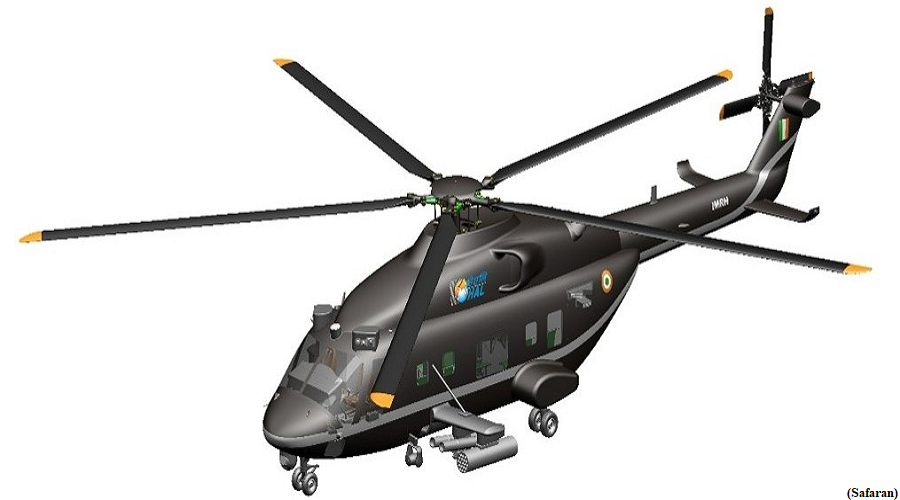Hindustan Aeronautics and Safran launch JV for helicopter engines (GS Paper 3, Defence)

Why in news?
- Hindustan Aeronautics Ltd (HAL) has incorporated a joint venture (JV) with France-based Safran Helicopter Engines under the name ‘Safhal Helicopter Engines Pvt Ltd’.
- The JV will design, develop, certify, produce, sell and support helicopter engines.
- The first opportunities identified are engines for the Indian Multi-Role Helicopter (IMRH) and Deck-Based Multi-Role Helicopter (DBMRH).
Safran-HAL Aircraft Engines facility:
- Safran-HAL Aircraft Engines facility is a 50/50 joint venture between French aerospace company Safran Aircraft Engines and state-owned defence PSU HAL.
- It was inaugurated in a Special Economic Zone near the Kempegowda International Airport in July 2022.
- The plant manufactures complex piping mostly for the LEAP engine.
Details:
- They would jointly develop industrial cooperation in manufacturing ring forgings for commercial aircraft engines.
- These products, which HAL and Safran will jointly produce in Bengaluru, will power the Airbus A320 Neo family and the Boeing 737 Max single-aisle airliners.
Background:
- HAL and Safran Helicopter Engines already have multiple partnerships, including the Shakti engine, which powers HAL-produced helicopters, including the Dhruv, Rudra and the Light Combat Helicopter (LCH). Over 500 Shakti engines have already been produced.
- Safran has been operating in India for 65 years and has 10 facilities and 750 employees nationwide.
Tremors reveal gaps in emergency alert system
(GS Paper 3, Disaster Management)
Why in news?
- When tremors hit Delhi and surrounding areas following the 6.4 magnitude earthquake in Nepal and the 5.6 magnitude aftershock, the government and private early alert systems did not reach many of the people who could feel palpable tremors.


Details:
- The National Disaster Management Authority (NDMA)’s Cell Broadcast Alert System (CBAS) has been tested in recent weeks to send out mass alerts when natural disasters strike, but it did not do so.
- Meanwhile, Google did not send out alerts in the national capital, even though tremors were felt in both instances here.
Android Earthquake Early Warning system:
- The Android Earthquake Early Warning system supplements the government’s efforts on earthquake alerts and aims to provide people with advance notice that can help them stay safe.
- It warns users only if the shaking in their area can expect to cross a value of 3.5 on the Modified Mercalli Intensity (MMI) Scale, a measurement of shaking during earthquakes that serves as an alternative to the Richter scale.
- At an MMI value of three (“weak” shaking), the United States Geological Service’s description of the scale says that tremors are felt “quite noticeably by persons indoors, especially on upper floors of buildings,” and at four (“light” shaking), the tremors are felt “indoors by many, outdoors by a few”.
- The tremors in both cases, in New Delhi, appear to have been in the lower end of these two MMI values, meaning Google did not send alerts to everyone who felt shaking, as the intensity did not seem as risky in places like Delhi.
CBAS:
- As for the CBAS, which is the alert system that works through telecom operators, no alerts went out anywhere in North India, even in places near the Nepal border where shaking was intense.
What is CBAS?
- The Cell Broadcast Alert System represents a cutting-edge technology that empowers us to disseminate critical and time-sensitive disaster management messages to all mobile devices within specified geographical areas, regardless of whether the recipients are residents or visitors.
- This ensures that crucial emergency information reaches as many individuals as possible promptly. Government agencies and emergency services employ Cell Broadcast to keep the public informed about potential threats and to provide vital updates during critical situations.
- Common applications of Cell Broadcast include delivering emergency alerts such as severe weather warnings (e.g., Tsunamis, Flash Floods, Earthquakes), public safety messages, evacuation notices, and other critical information.




